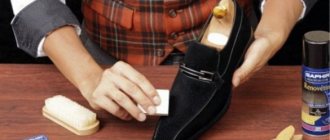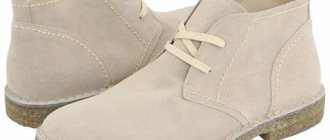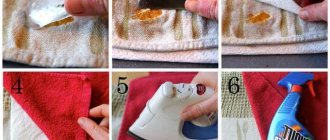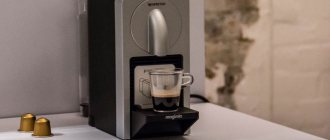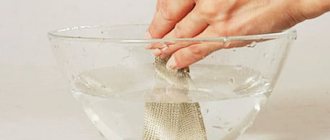Features of the material
Suede is leather tanned using fat tanning technology. To make suede, the skins of small animals, mainly calves and goats, are taken. This material is soft and velvety to the touch.
- In addition to its pleasant appearance, its advantages include the ability to retain heat, breathability, and hypoallergenic qualities.
- Disadvantages: constant vulnerability to damage, susceptibility to contamination, need for careful handling.
- Faux suede is a fabric that imitates tanned leather.
- Compared to its natural counterpart, it is more practical and has greater wear resistance. Externally, it is not much different from the original material.
Shoes, boots, and boots made of suede are classics that never go out of style. They are comfortable to wear, pleasant to the touch, and very attractive to look at.
Important Tips
Before putting on new suede shoes, treat them with a special protective spray. Use the product according to the season. For winter, autumn and early spring it is better to use water-repellent sprays. They allow the suede to remain dry even on very wet roads. In addition, after the sole and upper material dry, the suede remains beautiful and fleecy. For summer shoes made of special leather, it is better to use dust-repellent compounds. They preserve the brightness of a black product and the freshness of light-colored shoes.
After treating the suede with the spray, let it sit for at least three hours and only then put on your shoes. Renew the spray layers periodically approximately once every 2-3 weeks or as appropriate.
Interesting: How to clean a greasy sofa
Causes of suede contamination
Various problems arise when wearing suede shoes. Many of them depend on the personal characteristics of a person’s gait and his habits.
- Some people constantly stumble when walking or hit their feet.
- Wearing jeans on suede can cause abrasions. Chauffeurs are characterized by worn areas on their heels.
- Poor quality storage racks can also damage your shoes. Due to an ill-thought-out design, the front of the shoe may sink into the board, causing the appearance of the sock to deteriorate.
In winter, suede boots suffer from the reagents that litter the roads. These substances corrode suede and leave salt stains on it.
Basic Rules
To avoid spending long hours in the grueling process of cleaning a suede jacket or boots, it is worth pre-treating the surfaces with water-repellent compounds. They are freely available and are very reasonably priced. By taking care of purchasing such a product in advance, you can significantly protect your favorite bag or shoes from damage.
Natural suede cannot be washed. This is 100% damage to the product. Only faux suede can be subjected to this process, and then only with great care.
Under no circumstances is it recommended to dry such products near open fire sources or on radiators or heating appliances. Only careful, gradual drying in the fresh air.
Suede items do not tolerate stain removers and chlorine-containing bleaches. After the product has been wiped with a damp cloth, it must be dried immediately with dry sponges. And no hair dryer. The suede will simply wrinkle.
Suede items can be treated with soapy water. But in this case, the soap must be washed off, and then the material must be thoroughly dried.
Caring for suede shoes
Immediately after purchase, you should treat your shoes with a water-repellent solution in several layers. It is better to do this 2-3 times with a break of 15-20 minutes.
- To keep your shoes in good condition, you need to take care of them all year round.
- There are creams, aerosols, and impregnations against moisture and dust on sale. Suede should be protected from rain and snow. Any processing should be carried out in advance.
- If you follow these care rules, the life of your shoes will increase significantly.
If your shoes have stains, dirt, or deformations, there are ways to restore them and return them to an attractive appearance. There are many valid tips on how to clean natural suede.
Blood and wine
Another type of stain that is most likely to be found on a jacket or bag is blood or wine. They are difficult to remove even from simple fabrics, but we will give some tips on how to properly deal with stains.
The most important rule when cleaning blood is cold water. Under the influence of temperatures, the blood coagulates, then it will be almost impossible to clean it. Blot the area with a wet rag; if the stain remains and the blood is absorbed into the fibers, then make a concentrated soap solution. You can use the same products for it: washing powder and liquid soap. Shampoo will help remove wine; it is applied in the form of foam, left for 5-10 minutes, and the residue is removed with a towel.
You can use ammonia solution, it is important not to let the stains dry, they need to be cleaned within 2-3 days from the moment they appear. Colored surfaces can be cleaned with a low concentration alcohol solution, alcohol and water are taken in a ratio of 1:10, the stain is soaked, and then cleaned with a napkin.
Preparing for cleaning
If your shoes get wet after coming in from the street, the first thing you need to do is dry them. Shoe lasts are used for drying, helping the shoes maintain their shape. After walking on suede, wrinkles form, which are smoothed out with the help of these devices.
Suede shoes should be dried at room temperature. Do not use a hair dryer, radiator, heater or other artificial heat sources for drying. They make suede dry and brittle.
Tips for removing salt stains
Salt especially often settles on the surface of shoes in winter, when reagents are used to combat ice. There are several simple ways to remove white stains.
The fastest and most convenient option is to use a special eraser. It can be purchased at a shoe store; in extreme cases, use a clean office eraser. If you don’t have a suitable eraser at home, you can apply soap dissolved in warm water to the stains. Foam will appear on the material; it will definitely need to be removed along with excess moisture.
Another option is steaming using a steam generator.
Dry cleaning
If possible, it is better to use the dry cleaning method, since suede really does not like to come into contact with water. A large amount of moisture causes the pile to stick together and spoil its appearance.
- In case of dry contamination, it is enough to work with a brush to return the shoes to their previous condition.
- To clean suede from dust, any soft brush or even a sponge will do.
- Ideally, use a special rubberized brush for suede or a brush with natural bristles.
- People use dry bread crust.
After brushing, it is advisable to hold the shoes over hot steam to restore the fleecy layer. Alternatively, you can use an electric steam cleaner for this purpose.
Let's sum it up
Suede is a beautiful material with many advantages.
The maintenance requirements are more than compensated for by the aesthetics and nobility of this fabric.
If you want your expensive Timberland sneakers or fashionable UGG boots to retain their appearance for a long time, you need to try to ensure careful care.
Wet cleaning
Before quickly cleaning the suede, it is worth stuffing the inside with paper. This will protect it from deformation.
For this type of cleaning you will need:
- Brush or sponge for suede;
- Container with water;
- Soap, shampoo or special suede cleaner;
- Microfiber cloth or fluffy rag.
First you need to make a cleaning solution by diluting detergent in water. Then you need to moisten the brush in this liquid and wipe the dirt on the shoes in a circular motion. The resulting stain is blotted with a napkin or rag, and then steamed or treated with an eraser.
Cleaning furniture
We have learned how to deal with stains on clothes, but artificial material is also used for finishing furniture. Cleaning artificial suede should not be wet; you can use soap solutions or ammonia. A steam cleaner is perfect; it will lift the pile, refresh the fabric, and remove dust.
An artificial suede sofa can have two types of markings: W or S. In the first case, the letter will mean that the upholstery can only be cleaned with water-based products, in the second, that specialized solvents can be used. If you see a combination of two designations in the instructions, then you do not need to think about how to clean artificial suede; all means except washing will be appropriate.
Now you know the basics of caring for suede fabric. It doesn’t matter whether you bought an artificial or natural material, it requires care, then the stains will disappear quickly, and the item will delight you for a long time.
Video: how to clean any suede?
Special cleaning
To know what you can use to clean suede, you need to determine the type of contamination.
- To remove salt stains, you need to use 10% ammonia diluted with water.
- Starch or talc powder will help against traces of fat. It needs to be poured onto the stain and left for a couple of hours, then brushed off.
- If the origin of the stain is unclear, you can use a solution of ammonia and starch, or ammonia and chalk.
- The resulting semi-liquid mass is applied to the contaminated area and then removed.
- After this, the shoes are dried at room temperature. Residues are cleaned off with a brush.
In all cases, it is preferable to take your shoes to a dry cleaner so that they can clean your suede boots using professional methods. Attempting to clean it manually always runs the risk of ruining the situation even further.
How to clean dirt from suede at home
Suede products can only be cleaned dry.
The first thing that every owner of suede shoes should remember is that this material does not like moisture, and therefore it is impossible to wash such things as boots made of leather or dermantine under the tap. Cleaning suede at home involves the following procedures:
- Removing dust from the surface using a special brush.
- Removing stains, if any.
- Treating glossy surfaces with a stationery eraser.
- Raising the pile with a special “comb” for suede.
- Painting shoes.
- Treatment with water-repellent agents.
It is important to know that suede should only be cleaned after it has dried. The same applies to painting shoes - you can refresh the color when the cleaned material dries.
Color restoration
If your black suede shoes have faded, copy paper will help bring them back to their former brightness. Brown suede can be treated with coffee grounds. It is advisable to take shoes of other colors to the workshop.
- Light suede requires special care when caring.
- To clean such shoes, it is advisable to create a solution consisting of water, hydrogen peroxide and ammonia.
- Such shoes should be stored in a special place; you need to prepare a separate brush and sponge for them.
Such a capricious material as suede should be handled as carefully as possible. Under no circumstances should you apply the same products to it as to regular skin.
It is strictly forbidden to wash it in a machine or soak it in water. Avoid harsh metal brushes and aggressive chemical cleaning agents.
How to clean suede from salt at home
Vinegar cleaning works best on light-colored suede.
Winter shoes are often covered with white stains - these are traces of salt. You cannot clean them with a brush, so you need to do the following:
- Dry your shoes.
- Remove surface dirt with a brush.
- Treat the surface with a vinegar solution (1 part acid to 5 parts water).
- Wipe the surface with a damp sponge.
- Leave the boots to dry, stuffed with old newspapers.
During processing, try not to wet the suede too much; the material does not tolerate moisture well.
Photo of suede after cleaning
Hydrogen peroxide
Very suitable for light shades of suede. One teaspoon is enough - approximately 5 ml of product. It can be mixed with the same amount of ammonia, but it should be used independently.
Treat the fabric with a cotton pad soaked in the product and then wipe several times with a damp cloth. Drying with a piece of clean cloth.
- What to give your beloved husband something unusual for his birthday. List of ideas + video
- Can a non-owner of a car apply for compulsory motor liability insurance?
- Radon baths: indications and contraindications, reviews from doctors, benefits and harms, rules of administration
Primary processing
In order for the product to last much longer, it is necessary to carry out primary processing. When purchasing a comfortable pair of shoes, an unusual bag or gloves, you must also buy the following equipment and care items:
- A brush for suede - preferably a double-sided one, such that it has a brush with coarse small bristles, and also a rubber comb.
- A protective substance or spray, which can be colorless or with coloring components.
- Foam for cleaning suede - this product allows you to instantly and effectively remove various stains.
Having such an arsenal of tools, you don’t have to worry about how to clean your favorite thing, since now everything is at hand. Before putting on suede shoes for the first time, it is necessary to treat them with a spray, as a result of which a protective film is formed that will repel water.
Gasoline or kerosene
This is a more serious remedy. You need to work with it wearing protective gloves and very carefully so as not to damage the fabric. Gasoline can easily remove greasy stains and heavy dirt from suede.
After treatment, it is important to sprinkle these areas with soda or talcum powder, and then, after half an hour, wipe off the powder with your cheek.
